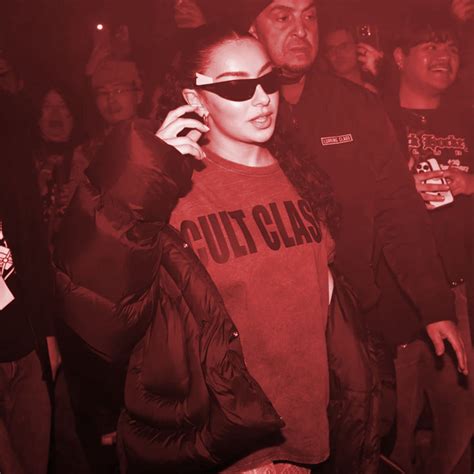
Charli XCX fans are sparking a viral trend of flipping Ford logo merchandise, drawing inspiration from the early 2000s Von Dutch craze and signaling a resurgence of Y2K fashion aesthetics. The trend, fueled by the singer’s influence and her fanbase’s embrace of distinctive self-expression, involves inverting the iconic Ford emblem on clothing and accessories as a playful homage to the trucker hat-wearing, pop-culture-obsessed era.
The “flipped Ford” phenomenon, as it’s becoming known, is rapidly gaining traction on social media platforms like TikTok and Instagram, where fans are showcasing their customized Ford apparel, sharing DIY tutorials, and connecting the trend to Charli XCX’s artistic style. This DIY fashion statement is more than just a fleeting fad; it’s a cultural commentary on nostalgia, brand appropriation, and the enduring appeal of Y2K aesthetics within Gen Z.
According to Yahoo Entertainment, the trend originated from a combination of Charli XCX’s influence, her fans’ penchant for unique fashion statements, and the broader resurgence of early 2000s trends. Social media has acted as a catalyst, amplifying the trend and creating a platform for fans to share their creations and interpretations. The trend is not officially endorsed by Ford, but it highlights the brand’s enduring recognition and the creative ways in which consumers are engaging with iconic logos.
The trend’s popularity underscores the cyclical nature of fashion, with Y2K trends making a significant comeback in recent years. This return to the aesthetics of the early 2000s reflects a broader cultural fascination with the perceived optimism and technological optimism of that era. The “flipped Ford” trend specifically taps into the Von Dutch trucker hat craze, a defining fashion statement of the early 2000s that epitomized the era’s blend of pop culture, celebrity influence, and mass consumerism.
One of the key factors driving the “flipped Ford” trend is the DIY aspect. Fans are not simply purchasing pre-made merchandise; they are actively creating their own customized pieces. This do-it-yourself approach allows for greater self-expression and fosters a sense of community among Charli XCX fans.
The trend also raises interesting questions about brand appropriation and the relationship between companies and consumers. While Ford has not officially commented on the trend, it highlights the power of consumers to reinterpret and repurpose brand logos in creative ways. This form of brand appropriation can be seen as both a tribute to the brand’s iconic status and a critique of consumer culture.
The “flipped Ford” trend serves as a microcosm of broader cultural trends, reflecting the enduring appeal of nostalgia, the power of social media to amplify trends, and the increasing importance of self-expression in fashion. As the trend continues to evolve, it will be interesting to see how it shapes the relationship between brands, consumers, and the ever-changing landscape of popular culture.
The appeal of the trend also lies in its accessibility. With readily available Ford logo merchandise and DIY tutorials circulating online, fans can easily participate in the trend without breaking the bank. This accessibility has contributed to its widespread adoption and its appeal to a younger generation of consumers.
The “flipped Ford” trend is also a testament to Charli XCX’s influence as a cultural icon. Her fans often look to her for inspiration in fashion, music, and overall style. By embracing the Y2K aesthetic and encouraging her fans to express themselves creatively, she has played a significant role in shaping the trend.
The trend is not without its critics. Some argue that it is simply a fleeting fad that will soon fade away. Others question the ethics of appropriating a brand logo without permission. However, the trend’s popularity suggests that it resonates with a significant portion of the population.
Ultimately, the “flipped Ford” trend is a complex phenomenon that reflects a variety of cultural forces. It is a testament to the enduring appeal of nostalgia, the power of social media, the importance of self-expression, and the ever-changing relationship between brands and consumers. As the trend continues to evolve, it will be interesting to see how it shapes the landscape of popular culture.
The trend has also sparked debate about the authenticity of Y2K revivals. Some argue that the current iteration of Y2K fashion is a watered-down version of the original, lacking the same edge and rebellious spirit. Others argue that the current revival is a more inclusive and diverse interpretation of the Y2K aesthetic, reflecting the changing values of society.
The “flipped Ford” trend can also be seen as a form of social commentary. By appropriating a brand logo and subverting its meaning, fans are making a statement about consumer culture and the power of brands to influence our lives. This form of social commentary is not unique to the “flipped Ford” trend; it is a common theme in contemporary art and fashion.
The trend also highlights the importance of community in the digital age. Fans are connecting with each other online to share their creations, exchange ideas, and support each other’s self-expression. This sense of community is a key factor driving the trend’s popularity.
The “flipped Ford” trend is a reminder that fashion is not just about clothing; it is also about identity, expression, and connection. By participating in the trend, fans are not simply wearing clothes; they are making a statement about who they are and what they believe in.
The trend also speaks to the growing interest in sustainable fashion. As consumers become more aware of the environmental impact of the fashion industry, they are increasingly looking for ways to repurpose and recycle clothing. The “flipped Ford” trend aligns with this trend by encouraging fans to customize existing merchandise rather than buying new clothes.
The trend also highlights the importance of inclusivity in fashion. As the fashion industry becomes more diverse, it is increasingly important to create trends that are accessible and appealing to people of all backgrounds. The “flipped Ford” trend is a relatively inclusive trend, as it does not require expensive clothing or specialized skills.
The “flipped Ford” trend is a complex and multifaceted phenomenon that reflects a variety of cultural forces. It is a testament to the enduring appeal of nostalgia, the power of social media, the importance of self-expression, and the ever-changing relationship between brands and consumers. As the trend continues to evolve, it will be interesting to see how it shapes the landscape of popular culture.
The DIY nature of the “flipped Ford” trend also promotes creativity and resourcefulness. Fans are encouraged to experiment with different materials, techniques, and designs to create their own unique pieces. This creative process can be empowering and fulfilling, allowing fans to express their individuality and connect with others who share their passion.
Furthermore, the trend challenges traditional notions of branding and marketing. By subverting the Ford logo, fans are demonstrating that brands do not have complete control over their image. Consumers can reinterpret and repurpose brand logos in ways that are both creative and critical. This challenges brands to be more responsive to consumer feedback and to engage with their audiences in a more authentic and meaningful way.
The “flipped Ford” trend also reflects a broader cultural shift towards personalization and customization. Consumers are increasingly looking for ways to express their individuality and to create products that reflect their unique tastes and preferences. The DIY nature of the trend allows fans to do just that, creating customized pieces that are truly one-of-a-kind.
The trend also highlights the blurring lines between high fashion and street style. In the past, high fashion trends were often dictated by designers and fashion houses, while street style trends emerged from the grassroots level. However, the “flipped Ford” trend demonstrates that these lines are becoming increasingly blurred, with street style trends influencing high fashion and vice versa.
The “flipped Ford” trend is a reminder that fashion is a dynamic and ever-evolving phenomenon. It is constantly being shaped by cultural forces, technological innovations, and consumer preferences. As the trend continues to evolve, it will be interesting to see how it reflects the changing values and priorities of society.
The trend also underlines the significance of subcultures in shaping mainstream fashion. What starts as a niche interest within a specific group can often gain wider recognition and influence, impacting broader fashion trends. This highlights the power of subcultures to innovate and push boundaries, ultimately contributing to the ever-evolving landscape of fashion.
The sustainability aspect of the “flipped Ford” trend resonates with a growing awareness of ethical consumerism. By repurposing existing materials and garments, fans are actively participating in reducing waste and promoting a more circular economy. This eco-conscious approach aligns with a broader movement towards sustainable practices within the fashion industry and beyond.
The trend can also be interpreted as a form of rebellion against mass-produced fashion. By creating their own customized pieces, fans are rejecting the homogenization of style and asserting their individuality. This act of defiance resonates with a desire for authenticity and self-expression in a world that often feels overly commercialized.
The “flipped Ford” trend’s success can be attributed in part to its visual appeal. The inverted logo creates a striking and eye-catching effect, making it easily shareable on social media platforms. This visual impact has contributed to the trend’s rapid spread and its widespread adoption by fans.
Ultimately, the “flipped Ford” trend is more than just a fleeting fashion fad. It is a reflection of broader cultural shifts, including the resurgence of Y2K aesthetics, the importance of self-expression, the power of social media, and the growing awareness of sustainability. As the trend continues to evolve, it will undoubtedly continue to shape the landscape of popular culture.
The trend also highlights the power of nostalgia to influence fashion trends. The Y2K aesthetic, with its emphasis on bright colors, bold patterns, and playful accessories, evokes a sense of nostalgia for the early 2000s. This nostalgia is particularly appealing to younger generations who did not experience the Y2K era firsthand but are drawn to its unique style and energy.
The “flipped Ford” trend also underscores the importance of collaboration between artists and brands. While Ford has not officially endorsed the trend, it highlights the potential for brands to collaborate with artists and influencers to create unique and engaging content. This type of collaboration can be mutually beneficial, allowing brands to reach new audiences and artists to expand their creative reach.
The trend also reflects a broader cultural movement towards deconstruction and reimagining of familiar symbols. By inverting the Ford logo, fans are challenging its traditional meaning and creating a new interpretation that is both playful and subversive. This deconstruction of familiar symbols is a common theme in contemporary art and design.
The “flipped Ford” trend is a reminder that fashion is a form of communication. By choosing to wear certain clothes and accessories, we are making a statement about who we are and what we believe in. The “flipped Ford” trend is a particularly powerful form of communication, as it allows fans to express their individuality, their creativity, and their connection to a broader cultural movement.
The trend also highlights the importance of authenticity in fashion. Consumers are increasingly looking for brands and trends that feel authentic and genuine. The “flipped Ford” trend is appealing because it is a grassroots movement that is driven by genuine passion and creativity.
The DIY nature of the trend also promotes skills development. Fans are learning new skills, such as sewing, crafting, and design, as they create their own customized pieces. This skills development can be empowering and fulfilling, allowing fans to express their creativity and build their confidence.
The trend also underscores the importance of community in the digital age. Fans are connecting with each other online to share their creations, exchange ideas, and support each other’s self-expression. This sense of community is a key factor driving the trend’s popularity and its longevity.
The trend also highlights the power of fashion to create a sense of belonging. By participating in the “flipped Ford” trend, fans are connecting with a community of like-minded individuals who share their passion for fashion and self-expression. This sense of belonging can be particularly important for young people who are still developing their identity.
The “flipped Ford” trend is a complex and multifaceted phenomenon that reflects a variety of cultural forces. It is a testament to the enduring appeal of nostalgia, the power of social media, the importance of self-expression, and the ever-changing relationship between brands and consumers. As the trend continues to evolve, it will be interesting to see how it shapes the landscape of popular culture.
Frequently Asked Questions (FAQ):
1. What is the “flipped Ford” trend and where did it come from?
The “flipped Ford” trend involves inverting the Ford logo on clothing and accessories as a fashion statement. It draws inspiration from the early 2000s Von Dutch trend and the resurgence of Y2K fashion aesthetics. It is believed to have originated from Charli XCX’s influence and her fans’ embrace of unique self-expression.
2. Is Ford officially involved or endorsing this trend?
As of the latest reports, Ford is not officially involved with or endorsing the “flipped Ford” trend. However, the trend highlights the brand’s enduring recognition and the creative ways in which consumers are engaging with its iconic logo.
3. How are people participating in the “flipped Ford” trend?
People are participating in the trend by purchasing Ford logo merchandise and then customizing it by inverting the logo. This can be done through various DIY methods, such as sewing, printing, or altering existing designs. Social media platforms like TikTok and Instagram are used to showcase these creations and share tutorials.
4. What is the connection between the “flipped Ford” trend and Charli XCX?
Charli XCX’s influence as a cultural icon and her fans’ appreciation for her unique style are key factors driving the trend. Her fans often look to her for inspiration in fashion and music, and her embrace of Y2K aesthetics has likely contributed to the trend’s popularity within her fanbase.
5. What does the “flipped Ford” trend say about current fashion and cultural trends?
The “flipped Ford” trend reflects the cyclical nature of fashion, with Y2K trends making a comeback. It also highlights the importance of self-expression, the power of social media to amplify trends, and the creative ways in which consumers are engaging with brand logos. Furthermore, it sparks debate about brand appropriation and the authenticity of Y2K revivals.









